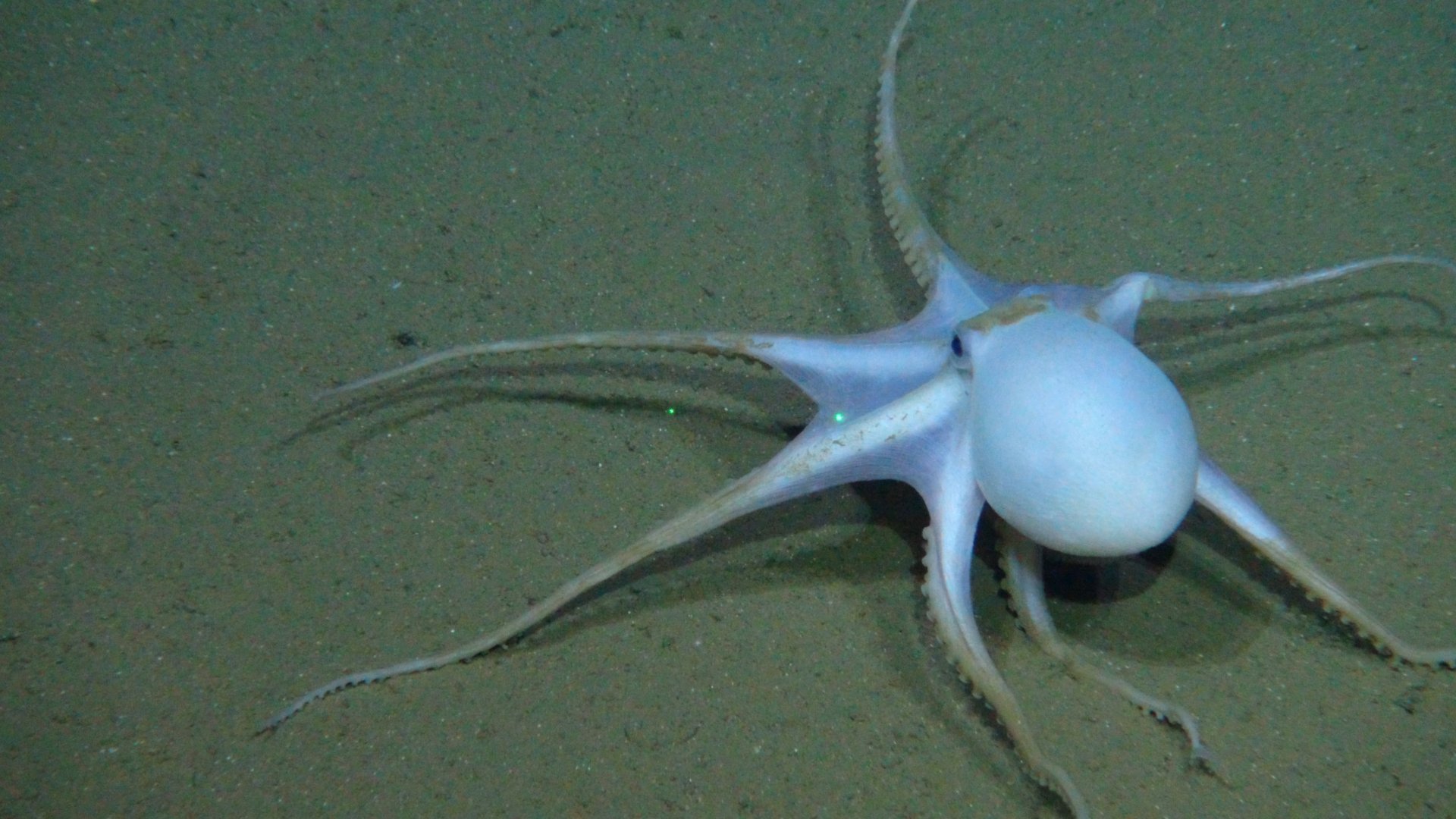- Press Office
- Manganese nodules as breeding...
Manganese nodules as breeding ground for deep-sea octopuses
Do you know Casper? In February this year, the deep-sea octopus (Octopoda, suborder: Incirrina) became a social media star within only a few days. The US diving robot Deep Discovery detected the approximately ten centimetre marine creature off the Hawaiian Necker Island at a depth of 4290 metres, taking close-up video and publishing the footage online.
The web community named the virtually transparent octopus Casper, after the famous cartoon ghost. The video was watched hun-dreds of thousands of times – but only now are researchers in the journal Current Biology revealing the extensive knowledge about life in the deep sea and the ecological significance of the manganese nodules that they have managed to tease out of the observation of this Hawaiian Casper octopus, and 28 additional observations of similar octopuses made elsewhere in the Pacific.
Without manganese nodules the octopuses cannot find a brooding ground
Two of the octopuses were seen by the camera system to be guarding their eggs. "At a depth of 4000 metres, these animals had deposited their eggs onto the stems of dead sponges, which in turn had grown on manganese nodules. The nodules served as the only anchoring point for the sponges on the otherwise very muddy seafloor. This means that without the manganese nodules the sponges would not have been able to live in this spot, and without sponges the octopuses would not have found a place to lay their eggs," the AWI researcher explains.
What's more: Even octopuses not actually brooding seek the proximity of manganese nodules and rocky protrusions. "The video footage indicates that the animals have cleaned the seabed around the nodules. It probably looks like that because the animals have been filmed using their arms to dig into the sediment around the nodules in search for food," says co-author Henk-Jan Hoving of the GE-OMAR Helmholtz Centre for Ocean Research.
The so-called DISCOL experiment from the late 1980s shows that many deep-sea animals need man-ganese nodules in their habitat. At the time, also in the Peru Basin, German researchers had removed manganese nodules by ploughing them into the seabed. In subsequent years, they observed the con-sequences of this human intervention on the deep-sea community. 26 years later, researchers of the expedition with RV Sonne returned to the place where the DISCOL experiment was carried out. Their conclusion: "The removal of the manganese nodules at that time caused the community of animals that are attached to the seafloor, which also includes sponges, to almost fully collapse. Even 26 years later many animal populations have not yet recovered," explain the authors in the new study.
"Our new observations show that we have to know about the behaviour of deep-sea animals and the specific way in which they adapt to their habitat in order to draw up sustainable protective and usage concepts," says AWI researcher Antje Boetius, head of the Sonne expedition to the Peru Basin.
Octopuses probably guard their spawn for many years
She classifies Casper and similar species as "particularly endangered" – as research has shown many deep-sea octopuses to only lay very few eggs and have extremely long reproductive cycles. Offspring of octopuses that spawn when in water temperature of three degrees Celsius have been observed to hatch after four years of continuous brooding. However, at the bottom of the Peru Basin, water tem-perature is a mere 1.5 degrees Celsius. "We therefore suspect that the octopus embryos here need many years to develop fully," says Antje Boetius. Disturbances during this important period would in all likelihood have serious consequences for the octopus offspring.
The observation data presented as part of the current study was collected during several expedi-tions. The shots from the Peru Basin were taken in the autumn 2015 during a research cruise by the German research vessel Sonne. The dives of the Deep Discovery robot near the Hawaiian Necker Island were part of an expedition of the US research vessel Okeanos Explorer and took place in Feb-ruary 2016. Further observations were made during a tour of the Kilo Moana research vessel in 2011.
The research was funded by the EU project "Managing Impacts of Deep-seA reSource exploitation (MIDAS)". The work on board the Sonne research vessel was made possible by the German Federal Ministry of Education and Research as part of the "Mining Impact of the Joint Programming Initiative Healthy and Productive Seas and Oceans (JPIO)" project.
Notes for Editors:
The study is published in the journal Current Biology under the following title:
Autun Purser, Yann Marcon, Henk-Jan T. Hoving, Michael Veccione, Uwe Piatkowski, Deborah Eason, Hartmut Bluhm, Antje Boetius: Association of deep-sea incirrate octopods with mangan crusts and nodule fields in the Pacific Ocean, Current Biology, December 2016; doi:
Photos and very attractive video material can be found in the online version of this press release at: ![]() http://multimedia.awi.de/medien/pincollection.jspx?collectionName=%7Bccd28eb5-c63c-2744-ad3d-71bd2c3af630%7D#1481814015981_4
http://multimedia.awi.de/medien/pincollection.jspx?collectionName=%7Bccd28eb5-c63c-2744-ad3d-71bd2c3af630%7D#1481814015981_4
Your scientific contacts at the Alfred Wegener Institute are:
Dr Autun Purser (tel: +49 (0)471 4831 - 1740; e-mail: autun.purser![]() awi.de)
awi.de)
Prof. Antje Boetius (tel: +49 (0)471 4831 - 2269; e-mail: Antje.Boetius![]() awi.de)
awi.de)
Your contact in the Communications and Media Department is Sina Löschke (tel.: +49 (0)471 4831 - 2008; e-mail: medien![]() awi.de).
awi.de).
Source "ROV-Team, GEOMAR" Further videos here ![]() https://ftp.geomar.de/users/skaehlert//Footage_SO242-2_Tiefseetintenfisch
https://ftp.geomar.de/users/skaehlert//Footage_SO242-2_Tiefseetintenfisch
Quelle "ROV-Team, GEOMAR" and fotos here ![]() http://multimedia.awi.de/medien/pincollection.jspx?collectionName=%7Bccd28eb5-c63c-2744-ad3d-71bd2c3af630%7D#1481814015981_4
http://multimedia.awi.de/medien/pincollection.jspx?collectionName=%7Bccd28eb5-c63c-2744-ad3d-71bd2c3af630%7D#1481814015981_4
For further questions please contact:
Head of Press & Communications
MPI for Marine Microbiology
Celsiusstr. 1
D-28359 Bremen
Germany
|
Room: |
1345 |
|
Phone: |

